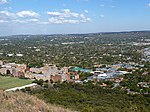South African Reserve Bank
The South African Reserve Bank (SARB) is the central bank of South Africa. It was established in 1921 after Parliament passed an act, the "Currency and Bank Act of 10 August 1920", as a direct result of the abnormal monetary and financial conditions which World War I had brought. The SARB was only the fourth central bank established outside the United Kingdom and Europe, the others being the United States, Japan and Java. The earliest suggestions for the establishment of the Central Bank in South Africa date back to 1879. A select committee, consisting of ten members of Parliament, was established on 31 March 1920 to examine the benefits to the national interest of the establishing of the central bank.Following on the recommendations of the committee, the South African Reserve Bank opened for business on 30 June 1921, making it the oldest central bank in Africa. The first banknotes were issued to the public by the Bank on 19 April 1922. Set of ZAR notes 2012 to present R 104 000 000 000.00 and Set of ZAR notes 2018 to present 400 000 000 print. Unlike the Bank of England, which provided the model for establishing the SARB, the SARB is privately owned.
Excerpt from the Wikipedia article South African Reserve Bank (License: CC BY-SA 3.0, Authors).South African Reserve Bank
Helen Joseph Street, Pretoria Tshwane Ward 58
Geographical coordinates (GPS) Address Phone number External links Nearby Places Show on map
Geographical coordinates (GPS)
| Latitude | Longitude |
|---|---|
| N -25.745277777778 ° | E 28.196111111111 ° |
Address
South African Reserve Bank
Helen Joseph Street 370
0002 Pretoria, Tshwane Ward 58
Gauteng, South Africa
Open on Google Maps






